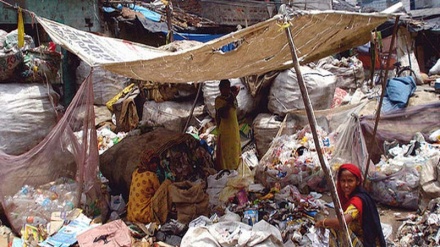We Only Have One Planet to Live On (17)
Welcome to the 17th weekly episode of the series We Only Have One Planet to Live On. In this episode, we study the destructive impact of haze on the environment.
One of the detrimental impacts of soil erosion and desertification is the emergence of haze, which consists of dust particles, and other dry particles, suspending in air. The phenomenon of haze occurs when the dust particles mount in a dry climate. This phenomenon at times leads to obstruction of sunrays, leading to a sharp drop in temperature. Thus, scientists believe that some of the major extinctions, such as extinction of dinosaurs, have been the consequence of occurrence of haze.
Another prime example of such incidents throughout the course of history is the eruption of a volcano in Indonesia; which covered a long distance and even impacted the city of London, upon arrival of dust particles and smog in this capital city. Such a large volume of haze impeded the arrival of sunrays, thereby causing a significant fall in temperature.
In fact, haze consists of very small particles which cover a long distance due to winds, as the result of soil erosion and desertification. These light suspending particles rise to high altitudes, and after a short while settle on the ground. The phenomenon of haze occurs throughout all global deserts, such as the deserts of Saudi Arabia, Iraq, Kuwait, and southern regions of Iran, especially throughout the warm season. The dust particles remain suspended in air for several days.
The permitted volume of dust particles in air, according to international standards, stands at 240-260 micrograms per cubic meter. However, upon the occurrence of haze, the volume of dust particles at times mounts even more than 15 times the standard volume. The chemical structure of these dust particles endangers the environment, and especially the health of mankind. The dust particles combine with pollutants in cities. These dust particles also become sticky due to their combination with organic materials, and thereby easily settle on the surface of plants, soil, and objects, spreading infectious diseases and allergies.
The recent studies on the dust particles which have emerged in Iraq and Saudi Arabia shows that over 56% of these particles are smaller than 250 microns in size and can therefore be easily inhaled by humans, deeply infiltrating their lungs, and negatively impacting the defense system of human body, such that even sneezes and coughs would not be able to remove these particles from lungs. These particles are later absorbed in the human blood, causing a number of illnesses. Moreover, based on scientific studies that have been carried out in the recent two decades, roughly 500,000 people die at a young age due to inhaling suspended dust particles in air, every year, across the globe. These dust particles also negatively impact plants. The settlement of dust particles on the surface of plants slows down photosynthesis in plants, thereby reducing the rate of growth and metabolism of plant species. Moreover, dust particles negatively affect pollination of plants, obstructing the formation of fruits. Additionally, dust particles deal major blows to economy.
Scientists opine that soil erosion, throughout regions with appropriate rainfalls, leads to emergence of dust particles to a lesser extent. However, this topic of concern is more evident in dry regions, such as Middle East, especially upon the blow of northern winds. These winds take shape in northern Middle East as of June to September, covering the deserts in Iraq and Syria, and stretching to Persian Gulf waters and high seas. These winds move the eroded soil, leading to arrival of dust particles over the regional industrial cities.
Based on the studies which the US National Oceanic and Atmospheric Administration has carried out in Iraq, the root cause of intensification of dust storms in Middle East, especially Iran, is the process of desertification in eastern Iraq. This region is located in proximity of Baghdad, between River Tigris and River Euphrates and was home to several wetlands and lakes in the past. However, the dryness of cane fields in southern Iraq throughout the 1980s and 1990s is a prime example of destruction of ecosystem in this region, highly contributing to emergence of dust particles in this region. The former Iraqi dictator, Saddam Hussein, within the framework of his wrong policies, allowed the sandstorms of Saudi deserts to reach the Iraqi cities of Najaf, Karbala, and Samara. He dealt a heavy blow against the regional ecosystem, sabotaging the migration of birds throughout wetlands located in southern Iraq. This destructive policy even impacted meadows and farmlands in Iraq. Such faulty policies directly and immediately impacted the lives of Iraqi people, in addition to causing air pollution and suspension of dust particles in air, throughout Iraq. Many other regional countries, including several cities of Iran, are still suffering from this environmental crisis.
Meanwhile, based on a UN report, the Turkish government, which in the recent decades has constructed several dams and has blocked the water current of Rivers Tigris and Euphrates, has also highly contributed to dryness of wetlands and lakes in Iraq and Syria and has mounted dust particles in Middle East region.
MR/MG


